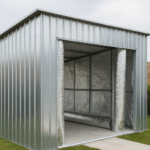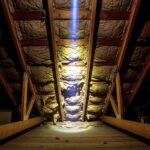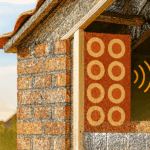Recently, many industries across India have widely adopted air bubble insulation over metal sheds as a thermal solution. Marketed as a lightweight, cost-effective way to reduce heat gain, questions remain among experts: Is air bubble insulation really effective? Can it sustain thermal performance reliably? Or is its popularity largely a market-driven myth?
How Air Bubble Insulation Works
Air bubble insulation consists of polyethylene bubbles sandwiched between reflective aluminum foil layers. The foil targets radiant heat by reflecting up to 95–97% of it, while the air bubbles slow conductive heat transfer. On paper, this combination sounds promising.
Thermal Performance: Key Numbers
The effectiveness of insulation is measured by its R-value (thermal resistance). Higher R-value means better resistance to heat flow.
| Material | Typical R-value (m²·K/W) |
| Air Bubble (Single) | 0.8 – 1.2 |
| Air Bubble (Double) | 1.2 – 1.8 |
| Rockwool | 2.5 – 3.0 |
| Fiberglass | 2.7 – 3.5 |
Compared to mineral fiber insulations like rockwool or fiberglass, air bubble insulation offers significantly lower thermal resistance.
Heat Transfer Formula
The heat transfer through insulation is estimated by:
Q= ΔT/R
where:
- Q = heat flow rate (W/m²)
- ΔT = temperature difference across the insulation (°C)
- R= total insulation resistance (m²·K/W)
Example Calculation
Assuming ΔT=8∘C (typical summer temperature difference):
- For air bubble insulation R=1.2
Q= 8/1.2 = 6.66 W/m2
- For rockwool R=2.7
Q= 8/2.7 = 2.96 W/m2
This simple calculation shows air bubble insulation allows over twice the heat transfer compared to rockwool.
Graph: Decline in Reflectivity and R-value Over Time
| Years Installed | Reflectivity (%) | Approximate R-value |
| 0 | 95 | 1.8 |
| 3 | 80 | 1.4 |
| 5 | 60 | 1.0 |
| 7 | 51 | 0.7 |
(Source: Field investigations in Indian climatic conditions)
Why Does Industry Prefer Air Bubble Insulation Despite These Limitations?
- Low Initial Cost: Air bubble insulation is cheaper in upfront material and labor costs compared to rockwool or fiberglass.
- Lightweight and Easy Installation: It can be quickly retrofitted onto existing metal sheds without major structural changes.
- Moisture Barrier: It somewhat reduces condensation and rust issues, a big concern in humid regions.
- Aggressive Marketing: Suppliers heavily promote air bubble as a “miracle solution,” influencing decisions without full technical due diligence.
Conclusion: Myth VS Reality
While air bubble insulation is better than no insulation, it does not match the thermal resistance or long-term durability of mineral fiber options used in industrial settings. The strong market push masks these technical shortcomings, creating a perception gap. For critical applications requiring stable, effective thermal protection, investing in proven alternatives like rockwool or fiberglass is advisable.
~Swapnil Pawar




